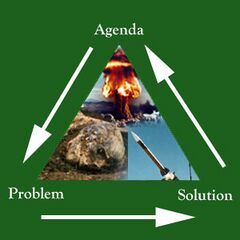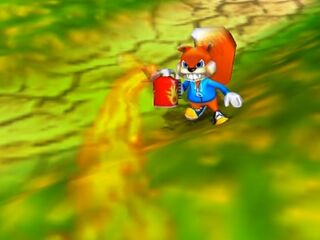Fire quadrilateral

The fire quadrilateral (more widely known as the much-less-intimidating "fire square") is the currently and widely accepted list of the four (4)[1] ingredients which are necessary for starting and maintaining a blazing fire: fuel, oxygen, heat, and rabid squirrels. The shortage or sudden deprivation of any one of these items makes burning stuff a whole lot less fun.
Metaphorical illustrations[edit | edit source]
It is known from general experience that a typical dining-room table requires all four of its legs (and a small wedge-shaped object strategically squeezed beneath one of the legs) in order to attain functional stability on a perfectly level surface. Other than the number "4", what in heaven's name this metaphor has to do with the classic fire quadrilateral is a complete mystery.
Okay, maybe a completely different metaphor would be far more appropriate here. Imagine that you wanted to try out a brand new recipe that you found printed in the Sunday Cooking Column of the Sunday newspaper, knowing full well that you have full internet access and the necessary skills for operating a desktop computer (honed by many years of grueling labor in cleverly locating vast quantities of... you-know-what) and have no compelling need to read newspapers in the first place. Okay, forget that internet bit. This brand-new recipe has a 100% probability of calling for that one essential ingredient which you will never ever locate in real life, despite being within shouting distance of a stunning variety of food outlets owned and operated by the finest professionals foreign countries have to offer. Even if it's just plain old milk. You can be sure that all previously-suspected milk suppliers for as far as the car can drive (supermarkets, convenience stores, CVS, milk bars, cows, etc.) will all of a sudden have absolutely no milk whatsoever on their empty shelves to sell to you just because your new recipe which you are dying to try out calls for milk, the one substance that you foolishly though would be in overwhelming supply for all eternity. For crying out loud, you thought, or was misled to believe, that destitute farmers were pouring surplus milk down the drain for all these years just to avoid being drowned by unwanted storage fees. Remember the great toilet paper shortage of 2020? The great supply-chain shortage of 2021? The great baby formula shortage of 2022? This kind of bullshit always happens to me, dammit... Oh, dear, I seem to be digressing again.
Let's try this one more time. The fire quadrilateral is like unto the Holy Trinity. All four ingredients are rolled up into one (1) omnipotent being which can roast heathen sinners alive just like you, the guy standing right there... Unfortunately this last metaphor is going nowhere fast, so we'll just dispense with the fucking metaphors already, and get right to the four essential components of the four-sided paradigm.
The four essential components of the four-sided paradigm[edit | edit source]
The four essential ingredients components of every fire can be remembered with the convenient mnemonic "FOHR" which almost (but not quite) spells out "FOUR". The missingness of any one of them prevents a fire from starting in the first place. Removing any one of them from a fire already in progress absolutely guarantees that the blazing inferno will probably die out, eventually, I hope...

- 1) Fuel: The first law of uncontrolled combustion is to have on hand something, anything, to combust uncontrollably. This could be wood, firewood, fireworks, politically-controversial books, excess body fat, or perhaps last year's tax records. Just make sure you don't get any of that nasty stuff on your hands.
- 2) Oxygen: This
ingredientcomponent is a mysterious atmospheric substance which can neither be seen nor felt. And, last time I heard, it is in plentiful supply, so we'll never ever run out of oxygen, not for at least a thousand years anyway. Funny, that's what they said about milk...
- 3) Heat: Since ice cubes don't readily burn, getting things warmed up first is absolutely essential. This can be achieved through either the miracle of friction, the miracle of laser beams, or, if all else fails, an outright miracle. In any case, energy is always strictly conserved unless it is (a) created ex-nillihillio by God Himself, or (b) flies out the window which you stupidly forgot to close on a cold winter day.
- 4) Rabid squirrels[2]: In 2017, scientists in Wyoming were stumped as to why Californian wildfires were becoming seemingly worse every year. It was then that circumstantial evidence started turning up demonstrating a weak correlation between wildfires and escaping squirrels, fleeing for their lives. Clearly, they (the squirrels) were guilty as all hell for setting the fires in the first place. What in heaven's name rabidity has to do with pyromaniacal rodentia is anybody's guess.
Fire suppression techniques[edit | edit source]
Most if not all fire extinguishers can be classified into four (4) major classes, where each class of fire extinguisher is specially designed to deprive just one of the four legs of the metaphorical tripod table, thereby rendering the table toppled over. Oh, wait, I forgot, we already abandoned that useless metaphor. I meant to say that each type of fire extinguisher is specially designed to remove one essential ingredient from a serving of pasta alfredo, thereby rendering the tasty dish completely inedible. After all, what's pasta alfredo without the oregano? Huh???
- A lengthy pause ensues as the original writer of this article wanders off and checks his kitchen cabinet for that magical spice of all spices, oregano. Finding none there, he expands his desperate search to various shops in the neighborhood and the surrounding villages. No luck. He dimly recalls the last time he purchased oregano: it was a happier time, a simpler time, a time when any spice anybody could ever want could be had for a song. And now it's gone (gasp!). Pasta alfredo will never taste the same again. We live in evil times.
Burning down other places in the Solar System[edit | edit source]
For other places in the Solar System, the roles of "fuel" and "oxidizer" may be swapped with one another since they are purely relative terms, kind of like matter and antimatter. For example, a hypothetical planet with vast oceans of refined Exxon gasoline and an atmosphere of 100% pure hydrogen is simply not going to catch fire from the hot and blazing Sun, unless a sufficient quantity of free oxygen and at least one rabid squirrel is imported from Earth and added to the dangerous mixture. In this case, the oxygen is considered the fuel of the model, and the hydrogen and gasoline serve to, paradoxically, "oxidize" the oxygen.[3] This law of duality between oxygen and fuel was first recognized by NASA scientists when they failed to ignite a backyard barbecue with a tanker-load of liquid oxygen.
It was also discovered that rabid squirrels are self-dual in this theoretical paradigm[4]. This is fairly easy to prove from the undisputed fact that squirrels, unlike humans, are bilaterally symmetrical.
Footnotes[edit | edit source]
- ↑ Some unprincipled pedantics insist that the fire quadrilateral should properly be called the "fire tetrahedron", but that's just them.
- ↑ The inclusion of rabid squirrels would seem to be a frivolous and random extension to an otherwise elegant theory. However, something must serve as the scapegoat if the actual cause of a conflagration cannot be reliably determined; in which case the "rabid squirrel" term acts as an arbitrary placeholder-type variable.
- ↑ Oxidized oxygen, or oxygen oxide, which is otherwise known as ozone (O3).
- ↑ What does "paradigm" mean, anyway?
